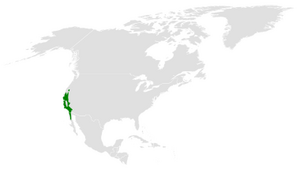Oak titmouse facts for kids
Quick facts for kids Oak titmouse |
|
|---|---|
 |
|
| In San Luis Obispo, California, United States | |
| Conservation status | |
| Scientific classification | |
| Genus: |
Baeolophus
|
| Species: |
inornatus
|
 |
|
| Range of Baeolophus inornatus | |
The oak titmouse (Baeolophus inornatus) is a small, gray-brown bird. It belongs to the tit family, Paridae. These birds are known as passerines, which means they are perching birds.
In 1996, scientists decided to split the "plain titmouse" into two different species. These were the oak titmouse and the juniper titmouse. They did this because the two birds had different songs, lived in different places, and had different DNA.
Contents
What Does an Oak Titmouse Look Like?
The oak titmouse is a small bird. It has a gray-brown color with a small tuft or crest on its head. Its face is plain, and its belly is a lighter gray. Male and female oak titmice look very much alike. This means there is almost no sexual dimorphism (differences between sexes).
Where Do Oak Titmice Live?
Oak titmice live all year long in the western parts of North America. You can find them from southern Oregon down through California. They live west of the Sierra Nevada mountains and go as far south as Baja California in Mexico.
These birds love warm, dry woodlands. They especially like areas with oak trees or a mix of oak and pine trees. They can also live in other forests if there are enough oak trees.
How Do Oak Titmice Behave?
Oak titmice often sleep in holes in trees or in thick bushes. They might also use birdhouses. When they sleep in bushes, they pick a branch with lots of leaves. This makes them feel safe, like they are in a cozy hole.
These birds usually live in pairs or small groups. They do not form large flocks like some other birds. After the breeding season, a pair might join other bird species to find food. But the male and female titmice usually stay together even after their young have grown.
What Do Oak Titmice Eat?
Oak titmice mainly eat insects and spiders. Sometimes, you can see them catching insects right out of the air! They also eat berries, acorns, and some seeds.
They look for food on leaves, small branches, and even on tree trunks. Sometimes, they hang upside down to reach food. They are clever birds and will hit seeds against branches to crack them open. Oak titmice also enjoy visiting bird feeders. They like suet, peanut butter, and sunflower seeds.
Oak Titmouse Sounds
The song of the oak titmouse is a series of repeated whistles. It has three to seven parts. The first part of each whistle is higher in sound than the next. Their call sounds like a scratchy tsicka-dee-dee.
Reproduction and Life Cycle
Oak titmice build their nests inside holes. They might use a hole made by a woodpecker, a natural hole in a tree, or a nest box. They build their nests with grass, moss, mud, hair, feathers, and fur.
They lay eggs from March to July, but most activity happens in April and May. A female usually lays 6 to 8 eggs, but it can be anywhere from 3 to 9. The female bird does most of the sitting on the eggs. This takes about 14 to 16 days.
When the chicks hatch, they are very helpless. Both parents take care of them in the nest for 16 to 21 days. After the young birds leave the nest, their parents continue to feed and care for them for another three to four weeks.
Oak Titmouse vs. Other Titmice
The oak titmouse looks very similar to the juniper titmouse. However, you can tell them apart by their voices and where they live.
- The oak titmouse has a browner back than the juniper titmouse.
- The oak titmouse's song has a series of three to seven parts, with each part having a low and a high note.
- The juniper titmouse's song has a series of fast notes all on the same sound.
Their living areas only overlap a little bit in California.
The tufted titmouse is another type of titmouse. It does not live in the same areas as the oak titmouse. The tufted titmouse has a whiter belly, reddish-brown sides, and a black patch on its forehead.
See also
 In Spanish: Herrerillo unicolor para niños
In Spanish: Herrerillo unicolor para niños



